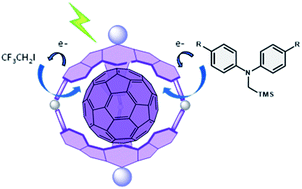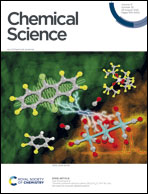Subphthalocyanine capsules: molecular reactors for photoredox transformations of fullerenes†
Abstract
The internal cavity formed by a dimeric subphthalocyanine (SubPc) capsule (SubPc2Pd3, 2), ensembled by coordination of pyridyl substituents in the monomeric SubPc 1 to Pd centers, has proved an optimal space for the complexation of C60 fullerene. Taking advantage of the intense absorption of green light of the SubPc component at around 550 nm, we have tested different green-light induced photoredox addition reactions over the double bonds of guest C60. Both addition of amine radicals, generated by reductive quenching of the excited state of 2 by aromatic trimethylsilylamines, and addition of trifluoroethyl radicals, obtained from oxidative quenching of the photosensitizer, have successfully taken place with good yields in the 2:C60 host:guest complex. On the other hand, both the photoredox reactions result in much lower yields when the monomeric pyridyl-SubPc is used as a photocatalyst, demonstrating that encapsulation results in a strong acceleration of the reaction. Importantly, this is the first example of the use of a confined microenvironment to trigger photoredox chemical transformations of fullerenes.

- This article is part of the themed collection: Most popular 2022 organic chemistry articles


 Please wait while we load your content...
Please wait while we load your content...